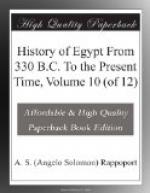In the number of ports which were then growing into the rank of cities, we see full proof of the great trade of Egypt at that time; and we may form some opinion of the profit which was gained from the trade of the Red Sea from the report of Clitarchus to Alexander, that the people of one of the islands would give a talent of gold for a horse, so plentiful with them was gold, and so scarce the useful animals of Europe; and one of the three towns named after the late queen, on that coast, was known by the name of the Nubian or Golden Berenice, from the large supply of gold which was dug from the mines in the neighbourhood. In latitude 17 deg., separated from the Golden Berenice by one of the forests of Ethiopia, was the new city of Ptolemais, which, however, was little more than a post from which the hunting parties went out to catch elephants for the armies of Egypt. Philadelphus tried to command, to persuade, and to bribe the neighbouring tribes not to kill these elephants for food, but they refused all treaty with him; these zealous huntsmen answered that, if he offered them the kingdom of Egypt with all its wealth, they would not give up the pleasure of catching and eating elephants. The Ethiopian forests, however, were able to supply the Egyptian armies with about one elephant for every thousand men, which was the number then thought best in the Greek military tactics. Asia had been the only country from which the armies had been supplied with elephants before Philadelphus brought them from Ethiopia.
The temple of Isis among the palm groves in Philae, a rocky island in the Nile near the cataracts of Syene, was begun in this reign, though not finished till some reigns later. It is still the wonder of travellers, and by its size and style proves the wealth and good taste of the priests. But its ornaments are not so simple as those of the older temples; and the capitals of its columns are varied by the full-blown papyrus flower of several sizes, its half-opened buds, its closed buds, and its leaves, and by palm-branches. It seems to have been built on the site of an older temple which may have ’been overthrown by the Persians. This island of Philo is the most beautiful spot in Egypt; where the bend of the river just above the cataracts forms a quiet lake surrounded on all sides by fantastic cliffs of red granite. Its name is a corruption from Abu-lakh, the city of the frontier. This temple was one of the places in which Osiris was said to be buried. None but priests ever set foot on this sacred island, and no oath was so binding as that sworn in the name of Him that lies buried in Philae. The statues of the goddess in the temple were all meant for portraits of the queen Arsinoe. The priests who dwelt in the cells within the courtyards of the temples of which we see the remains in this temple at Philae, were there confined for life to the service of the altar by the double force of religion and the stone walls. They showed their zeal for their gods by the amount of want which they were able to endure, and they thought that sitting upon the ground in idleness, with the knees up to the chin, was one of the first of religious duties.




